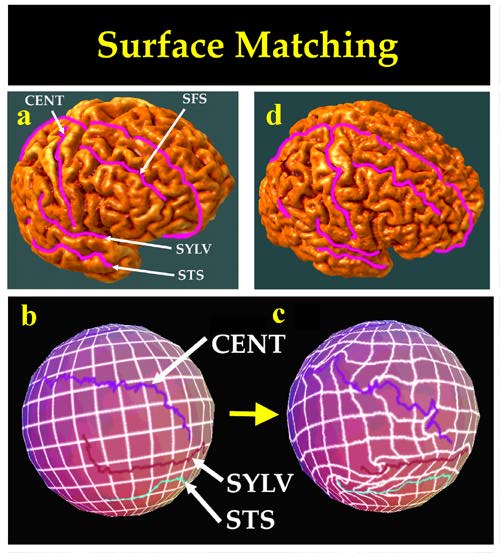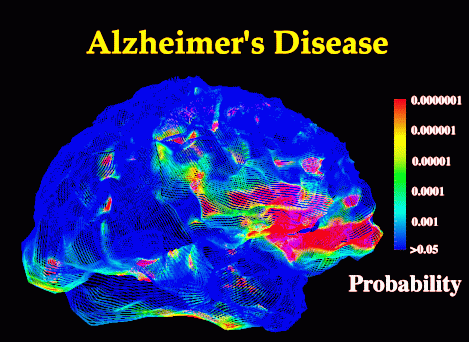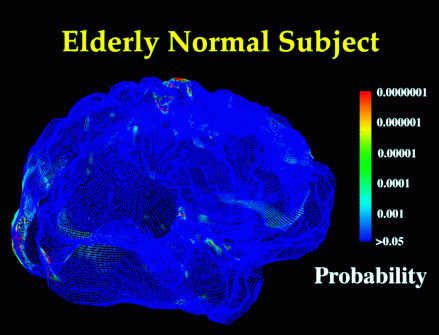Paul Thompson's Research Publications
Detection and Mapping of Abnormal Brain Structure with a Probabilistic
Atlas of Cortical Surfaces
Journal of Computer Assisted Tomography, 21(4):567-581
Paul M. Thompson, David MacDonald, Michael S. Mega, Colin J. Holmes, Alan C.
Evans,
Arthur W. Toga
Laboratory of Neuro Imaging and Alzheimer's Disease Center, Department of
Neurology, Division of
Brain Mapping, UCLA School of Medicine, Los Angeles, California
90095
and
Montreal Neurological Institute, McGill University, Quebec, Canada
|
ABSTRACT

Purpose.
We have devised, implemented, and tested a technique for creating a
comprehensive probabilistic atlas of the human cerebral cortex, based on
high-dimensional fluid transformations. The goal of the atlas is to detect and
quantify subtle and distributed patterns of deviation from normal cortical
anatomy, in a 3D brain image from any given subject.
Method.
Given a 3D MR image of a new subject, a high-resolution surface representation
of the cerebral cortex is automatically extracted. The algorithm then
calculates a set of high-dimensional volumetric maps, fluidly deforming this
surface into structural correspondence with other cortical surfaces, selected
one by one from an anatomic image database. The family of volumetric warps so
constructed encodes statistical properties of local anatomical variation across
the cortical surface. Additional strategies are developed to fluidly deform the
sulcal patterns of different subjects into structural correspondence. A
probability space of random transformations, based on the theory of anisotropic
Gaussian random fields, is then used to encode information on complex
variations in gyral and sulcal topography from one individual to another. A
complete system of 256x256 probability density functions is computed to reflect
the observed variability in stereotaxic space of the points whose
correspondences are found by the warping algorithm. Confidence limits in
stereotaxic space are determined for cortical surface points in the new
subject's brain.
Results.
Color-coded probability maps are generated, which highlight and quantify
regional patterns of deformity in the anatomy of new subjects. These maps
indicate locally the probability of each anatomic point being as unusually
situated, given the distributions of corresponding points int he scans of
normal subjects. 3D MRI volumes are analyzed, from subjects with
clinically-determined Alzheimer's Disease and age-matched normal subjects.
Conclusion. Applications of the random fluid-based probabilistic atlas
include the transfer of multi-subject 3D functional, vascular, and histologic
maps onto a single anatomic template, the mapping of 3D atlases onto the scans
of new subjects, and the rapid detection, quantification, and mapping of local
shape changes in 3D medical images in disease and during normal or abnormal
growth and development.
|
|

Detection of Abnormal Brain Structure:
Mapping of the Brain of an Alzheimer's Disease Patient
|

Same Map Constructed for an Age-Matched
Elderly Normal Subject
|
|
Index Terms. Brain, Mapping-Image Registration-Atlas and
Atlases-Stereotaxic Imaging-Magnetic resonance imaging-Image reconstruction,
three-dimensional-Morphometry.
Related Publications
PICTURES EXPLAINING THE BRAIN ATLAS
other research areas
(back to main list)
Contact Information
Mail:
Paul Thompson
73-360 Brain Research Institute
UCLA Medical Center
10833 Le Conte Avenue
Westwood, Los Angeles CA 90095-1761, USA.
E-mail:
thompson@loni.ucla.edu
Tel: (310)206-2101
Fax: (310)206-5518


